The uncanny valley, a phrase coined by Japanese robotic researcher Masahiro Mori nearly three decades ago, describes the uncanny feeling that occurs when people look at representations designed to be as human-like as possible – whether computer animations or androids – but somehow fall short. It turns out monkeys have that too.
In an attempt to answer deeper questions about the evolutionary basis of communication, Princeton University researchers have found that macaque monkeys also fall into the uncanny valley, exhibiting this reaction when looking at computer-generated images of monkeys that are close but less than perfect representations.
In the experiments, the monkeys, which normally coo and smack their lips to engage each other, quickly avert their glances and are frightened when confronted by the close-to-real images. When asked to peer at the less close-to-real faces and real faces, however, they viewed them more often and for longer periods.
Despite the widespread acknowledgment of the uncanny valley as a valid phenomenon, there are no clear explanations for it, researcher Asif Ghazanfar explains. One theory suggests that it is the outcome of a "disgust response" mechanism that allows humans to avoid disease.
Another idea holds that the phenomenon is an indicator of humanity's highly evolved face processing abilities. Some have suggested the corpse-like appearance of some images elicits an innate fear of death. Still others have posited that the response illustrates what is perceived as a threat to human identity.
The work indicates that there is a biological basis for the uncanny valley and supports theories that propose that the brain mechanisms underlying the uncanny valley are evolutionary adaptations.
Via NRC. Source: Princeton University.


Comments (0)
Share your thoughts and join the technology debate!
No comments yet
Be the first to share your thoughts!